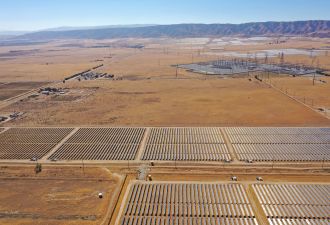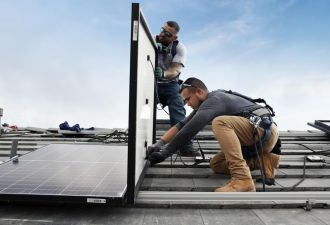The Holy Grail for variable renewable energies like wind and solar, holds conventional wisdom, is storage capability. However, like much conventional wisdom, that’s not the whole story.
“An additional twenty megawatts of regulation service,” said AES Energy Storage President Chris Shelton, citing a recent New York Independent System Operator (NYISO) report, would “support the adoption of the more than 4,000 megawatts of wind power in the New York queue.”
Regulation service is purchased by Independent System Operators (ISOs) in a specialized marketplace. Compared to overall energy consumption, it is relatively small. Grid operators use it to handle unplanned drops in supply or spikes in demand, like when air conditioning use goes sharply up on a hot afternoon or a power line goes down. Regulation services must be instantly dispatchable.
System operators do this, Shelton said, by “throttling power plants up and down.” Recent reports from grid operators confirm that battery storage can provide the same regulation service, Shelton said. “In fact, storage is faster and more flexible than the power plants.”
Batteries provide, Shelton said, “a central warehousing function for the entire grid.” They don’t have to provide energy over a long period of time, Shelton said. It is “a power-balancing question rather than an energy-delivered question,” he explained.
The technology to store energy for regulation services is a new tool but it is not hypothetical, Shelton said. “The batteries that we have and that we have been operating for years are fast and flexible, and lithium ion, in particular, is very efficient.”
AES Energy Storage’s first larger-scale battery-based system was installed at an AES Corp substation in northern Chile, where mining operations, periodic power plant failures and transmission outages were causing load variation and affecting reliability, Shelton said. “We were able to provide a very fast response and a very flexible system to deal with that unmanaged variation.”
Grid operators anticipate the same kind of challenge, Shelton said, as more renewable energy is introduced. They have identified that they will require more regulation services to manage the increased variability. “And we have a targeted solution,” Shelton said.
The Holy Grail, therefore, may not be storing renewable energy where it is generated but building energy storage centrally so that the ISO can use it when it is needed. “Our focus is on the grid as whole,” Shelton stressed, “not just on renewables.”
Shelton anticipates that the new AES Energy Storage twenty-megawatt project just coming on line in New York will perform as successfully as the twelve-megawatt project in Chile. “Again, that is not a renewables-specific project; it’s a project focused on delivering regulation service.” But, he added, because it resolves issues of reliability associated with variability, “it’s an enabler of renewables.”
System operators purchase regulation services at market-determined prices. AES Energy Storage expects to sell its regulation product into that market at a competitive price. “We expect a decent return,” Shelton said. “We’ll get paid the market clearing price for the service we provide.” It is, he added, “a completely commercial endeavor.”
Shelton was confident the AES Energy Storage regulation services will be cost-competitive. Besides insights from parent AES Corp’s experience as a fossil fuel-generated energy supplier, the storage subsidiary has done a series of one-megawatt pilot projects and market studies that established the market dynamics, costs and returns for battery storage systems.
It is even possible excess renewable energy can be used to charge batteries and balance system variability. “If you add a tremendous amount of renewables, you could end up ramping [fossil fuel] plants up and down more,” Shelton said. That could create an emissions problem. “But if you use storage, you don’t have that.”
The volume of regulation services needed at present is established. That demand for them will grow as renewables become a larger factor in power generation is clear. The capacity to meet present and future needs with battery storage, according to Shelton, is entirely achievable.
AES Energy Storage has experience with major suppliers of lithium ion technology such as A123 Systems, Altairnano and Samsung SDI. It generally finds the lead-time for delivery on a grid storage system is nine months.
“You’re going to see system operators get more comfortable with this,” Shelton said. “A huge, 800-megawatt power plant may only be able to move twenty megawatts in one minute. Our New York project,” he said, “will be able to move twenty megawatts in less than one second.”
Having seen what grid energy storage can do, the Federal Energy Regulatory Commission (FERC) and the ISOs are already thinking about moving to “pay-for-performance,” Shelton said. “Instead of procuring a set amount of megawatts,” Shelton said, ISOs are beginning to realize they can ask for precisely what they need and pay for only that.
And more capability is coming, Shelton said. Though there are currently no federal incentives to stimulate grid storage development, something Shelton thought should be rectified, there is already a tremendous amount of investment in vehicle batteries.
“$2.4 billion was invested by the Recovery Act in battery manufacturing for vehicles,” Shelton said. The price expectation from that Recovery Act investment for a vehicle battery in 2015, he said, is $350 per kilowatt-hour. “Those numbers,” Shelton said, “start to look interesting in the grid space.”



